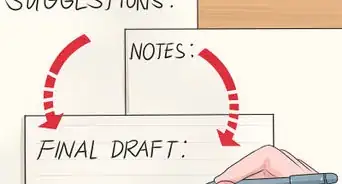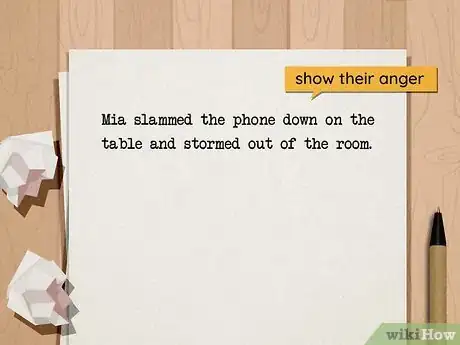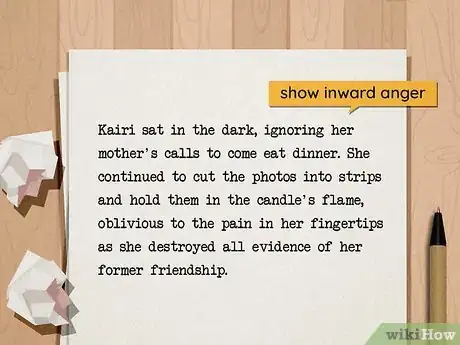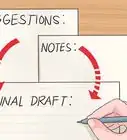This article was co-authored by wikiHow staff writer, Jennifer Mueller, JD. Jennifer Mueller is a wikiHow Content Creator. She specializes in reviewing, fact-checking, and evaluating wikiHow's content to ensure thoroughness and accuracy. Jennifer holds a JD from Indiana University Maurer School of Law in 2006.
There are 7 references cited in this article, which can be found at the bottom of the page.
wikiHow marks an article as reader-approved once it receives enough positive feedback. In this case, 86% of readers who voted found the article helpful, earning it our reader-approved status.
This article has been viewed 77,377 times.
Learn more...
You can't write a great story without emotion and anger can be one of the most powerful emotions people have. What makes a character angry and how they deal with that anger tells your readers a lot about that character. To make it compelling, though, you can't just have a character say "I'm angry." They need to show that anger through action that advances the plot. Here, we've gathered some ideas you can use to express anger in your writing.
Steps
Show the angry character's behavior.
-
Rudeness and violence can indicate the character is angry. When people get angry, they may do things they wouldn't normally do. Usually, this involves being mean to someone else. Have your angry character yell and scream, push another character, punch a wall, or throw something.[1] X Research source
- For example, you might write: "Mia slammed the phone down on the table and stormed out of the room." While your character hasn't involved anyone else, it's pretty obvious from her behavior that she's angry.
- For a more confrontational scene, you might write: "Kale stepped toward Micah, glaring at him. Before Micah could react, Kale shoved him backward, screaming, 'How could you do that?'"
Describe the character's facial expression.
-
Write about how feeling anger transforms the character's expression. Anger is a transformative emotion: eyebrows scrunch together, foreheads crease, lips tighten, jaws tense, nostrils flare. Including these characteristics in your writing shows your readers that your character is angry.[2] X Research source
- For example, you might write: "Alex's nostrils flared as he stared at Jenna. He couldn't believe she'd taken Michael to the game without asking him first."
- Here are some other phrases: "hostile glare," "face contorted with rage," "bared teeth," "curled lip," "clenched jaw."
- Eyes are often considered containers or gateways to emotional expression, so you can also show anger just by describing the character's eyes.[3] X Research source For example, you might write, "Jenna's eyes hardened and narrowed into slits as she watched Tara enter arm-in-arm with her ex-girlfriend, Mia."
Add angry body language.
-
Make the character take up more space with their body. This works especially well if the character is expressing their anger outwardly or even with violence. Puff out their chest, have them clench their fists, spread their feet, straighten their back, or loom over someone.[4] X Research source
- For example, you might write: "Brooklyn stood, their fists clenched by their sides, and rolled their shoulders back, glaring at Trinity. 'Care to say that again?'"
- Other angry body language includes wild gestures, pointing at or grabbing another character, pacing rapidly, or tensing their muscles.
Include physical side effects triggered by anger.
-
Show how the emotion affects the character. When you're angry, your body pumps adrenaline into your bloodstream. This can cause you to sweat or tremble and speed up your breathing and heart rate. Including these physical side effects not only shows anger but also might trigger empathy for the angry character.[5] X Research source
- For example, you might write: "Sara's heart raced in her chest as she looked at her phone. She willed her hand to stop shaking as she slowly read the text again."
- Other physical effects of anger include pulsing or throbbing veins, a flushed face or neck, a dry mouth, or breathlessness.
Report the angry character's thoughts.
-
This option works best if you're writing in the first person. When the angry character is also the narrator of the story, it's easy to talk about what's going through their head as anger builds inside them. Their thoughts become part of the action of the story, even if they don't end up doing anything to express their anger outwardly.[6] X Research source
- For example, you might write: "The room felt like it was closing in around me. In my mind, I was growing larger and larger, expanding with rage. If I didn't do something, fast, to get myself under control, I'd explode and take out everyone and everything around me."
- This can also work in a third-person narrative if your narrator is omniscient. For example, you might write: "Kieran gripped the glass in his hand. His first thought was to throw it to the floor and smash it, but he knew if he did that, he wouldn't stop until every glass in the cupboard was in shards."
Describe how other characters react to the anger.
-
Indicate anger through other characters' fear, concern, or awkwardness. If you have a more stoic character who doesn't make such dramatic outward displays of anger, others who know them can do the work for you. If others recognize the anger and retreat or back away, it signals to your reader that they should feel the same way.[7] X Research source
- For example, you might write: "Mara looked away from Sean and slumped in her chair, crossing her arms across her chest. The more he fumed, the smaller she made herself."
- You might also have another character attempt to calm or restrain the angry character. They might say something like, "Hey, easy man—no need to get worked up," or "There are more important things—just let it go."
- For yet another option, have a character throw out an obvious (and awkward) distraction or attempt to change the subject. Make it clear in your narration that they're trying to divert attention from either the angry character or the source of the anger.
Use an abrupt, staccato sentence structure.
-
Show a character's anger through the rhythm of your narrative. This works especially well if the angry character happens to be the narrator, but you can use it in third-person writing as well. Use short sentences and sharp, edgy words to up the tension and increase your reader's sense that something bad is about to happen.[8] X Research source
- For example, you might write: "Ronan made his way across the dance floor with eyes shooting lasers. The walls. The speakers. The lights. The DJ. Smiles crashed and laughter died. Only Josh and Sam danced on, oblivious."
- Go for short, harsh-sounding words like "smash," "crash," "halt," "force," "blast," or "slam."
Express inner turmoil by having a character isolate themselves.
-
Inward anger and turmoil can be just as powerful as outward anger. People (and fictional characters) express anger in different ways. While some might act out, others take it inward. Showing inward anger is a great way to make your character more realistic.[9] X Research source
- For example, you might write: "Kairi sat in the dark, ignoring her mother's calls to come eat dinner. She continued to cut the photos into strips and hold them in the candle's flame, oblivious to the pain in her fingertips as she destroyed all evidence of her former friendship."
- Your character might be angry at themselves more than anyone else. They might also be mad at a situation but blame themselves for that situation. In those scenarios, they're more likely to take that anger out on themselves than on someone else.
- Other ways a character might take anger out on themselves include isolating themselves from others, refusing comfort from others, or hurting themselves.
Use sarcasm to show passive-aggressive anger.
-
Dialogue helps show passive-aggressive anger or resentment. Unless the character is also your narrator, it's unlikely your readers have insight into their deepest thoughts. This can make passive anger hard to express since it mostly happens in the character's head and isn't often shown outwardly. However, giving the character a bit of an attitude and a snarky tone can help.[10] X Research source
- For example, you might write: "'Hey, dinner's ready. Thanks for all your help,' Hermione said, rolling her eyes. After 4 hours in the kitchen, the least they could do is eat."
- Another good way to convey sarcasm is to have your angry character say the opposite of what would be expected. For example, if someone lets a door close in your angry character's face, they might say "Thanks for holding the door for me, I appreciate it!"
- Using over-the-top adjectives is another way to convey sarcasm. For example, suppose you have a character who tries to distract your angry character by asking if they've seen a film that was recently released. Your angry character might reply, "Yes, and it was glorious. Now, can we get back to what happened in the kitchen?"
Avoid adjectives that describe emotions.
-
Telling readers about anger doesn't allow them to experience it. A compelling narrative brings readers into the story and enables them to feel the emotion themselves. It shows them how the emotion feels for the character, giving them more information about your character's personality and who they are.[11] X Research source
- For example, instead of writing "Even though it had been 5 years, John was still angry at Susan," you might write "Even though it had been 5 years, John's face still burned when he thought of Susan's betrayal."
Warnings
- Avoid clichés. A phrase that's been overused to show anger won't have the impact a more original phrase would.⧼thumbs_response⧽
You Might Also Like



-Writing-Step-16.webp)


 15 Ways to Make Your Writing Longer (and Get Through Writer's Block)
15 Ways to Make Your Writing Longer (and Get Through Writer's Block)

References
- ↑ https://yolandiehorak.com/2018/05/23/lets-write-anger/
- ↑ https://allwritealright.com/how-to-describe-facial-expressions-in-writing/
- ↑ https://www.researchgate.net/publication/312028802_CONCEPTUALIZATION_OF_ANGER_IN_ENGLISH_POP_FICTION_STORIES
- ↑ https://yolandiehorak.com/2018/05/23/lets-write-anger/
- ↑ https://allwritealright.com/how-to-describe-facial-expressions-in-writing/
- ↑ https://yolandiehorak.com/2018/05/23/lets-write-anger/
- ↑ https://yolandiehorak.com/2018/05/23/lets-write-anger/
- ↑ https://yolandiehorak.com/2018/05/23/lets-write-anger/
- ↑ https://allwritealright.com/writing-a-character-with-anger-issues/
- ↑ https://www.writersdigest.com/there-are-no-rules/creating-emotional-frustration-in-your-characters
- ↑ https://www.pandorapost.com/2021/03/show-dont-tell.html
- ↑ https://allwritealright.com/writing-a-character-with-anger-issues/
- ↑ https://www.masterclass.com/articles/how-to-write-emotion#how-to-evoke-emotion-in-your-writing
About This Article























-Writing-Step-16.webp)


































